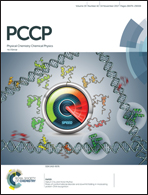Experimental and theoretical study of the collisional quenching of S(1D) by Ar†
Abstract
We present an experimental and theoretical investigation of the deactivation rate of S(1D) atoms by collisions with argon. Kinetic measurements were performed at temperatures from 5.8 K to 298 K in cold uniform supersonic flows using a CRESU (Cinétique de Réaction en Ecoulement Supersonique Uniforme or Reaction Kinetics in a Uniform Supersonic Flow) apparatus. In order to simulate them, ab initio electronic structure calculations using internally contracted MRCI methodology were performed to describe the interaction. Starting from them, close-coupling calculations were carried out to determine collisional quenching probabilities for the transition S(1D) → S(3P) in the energy range 1–3000 K (1 K ≈ 0.7 cm−1), sufficient to calculate thermal rate coefficients up to 300 K. Stückelberg-like oscillations in the quenching probabilities as a function of the energy are found and interpreted using a semiclassical model. Differences between the temperature dependence of the experimental and theoretical rate coefficients are detected at low temperatures. They are discussed in the light of a study of the high sensitivity of the theoretical results to the potential curves, due to the interference mechanisms which underlie the process.

- This article is part of the themed collection: 2017 PCCP HOT Articles


 Please wait while we load your content...
Please wait while we load your content...